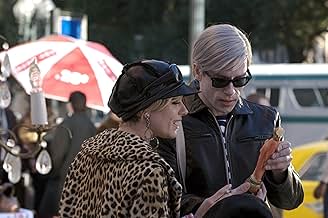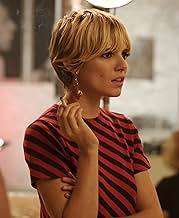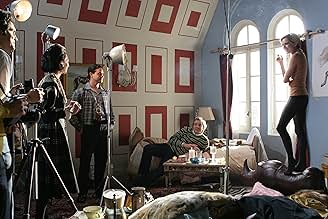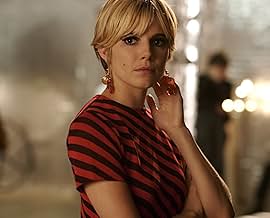Basado en el ascenso y caída de la socialité Edie Sedgwick, concentrándose en sus relaciones con Andy Warhol y una cantante de folk.Basado en el ascenso y caída de la socialité Edie Sedgwick, concentrándose en sus relaciones con Andy Warhol y una cantante de folk.Basado en el ascenso y caída de la socialité Edie Sedgwick, concentrándose en sus relaciones con Andy Warhol y una cantante de folk.
- Dirección
- Guionistas
- Elenco
- Premios
- 1 nominación en total
Opiniones destacadas
Guy Pearce delivers a very acceptable performance. Hayden Christensen, playing a fictional character so obviously meant to be Bob Dylan, is ludicrously weak, having none of the self-containment and gravitas of a great musician and poet, even a young one. Sienna Miller is a revelation, and worthier of a much better film than this one, which is flawed by poor conceptualisation. Even before it was completed, Factory Girl alienates the people who could have helped to make it great.
Some of the Factory denizens who bought into and eventually shared Warhol's artistic vision became products of his genius in a conscious way. They achieved independence and recognition in their own right. People like Paul Morrissey, the Velvet Underground (including Lou Reed, John Cale, and Nico). Edie Sedgwick, sadly, lost sight of the artist within her and never quite made it. She wanted to be famous - Warhol gave her that. She would have needed her own creative diligence to consciously realise what made her a star and so become autonomously successful.
To be fair to the film, the complaints, lawsuits and criticisms of the likes of Lou Reed and Bob Dylan seem without substance. The film does not blame Warhol or Dylan for Sedgwick's demise. The panda-eyed, drug-abusing wash-out that is the Sedgwick nearer the end of the movie does, but the audience can hardly say anything except she brought about her own downfall: she ingratiated herself to Warhol and his world when she was a nobody without even a job, then moaned that she couldn't work when he dumped her, when in fact she was obviously unemployable because of her drug habit.
The film's only real crime is perhaps that it celebrates the life of Edie rather than Andy, and that not particularly well. Seeing her at her height through the eyes of Andy Warhol would have achieved much more. Both 'sides' of the bitter split between the two of them agree she had, at one point, remarkable presence, charisma, and on screen talent. An occasionally more Warholian approach to the cinematography, while keeping the film accessible, could have emphasised such qualities with self-conscious camera-work and other devices. Instead, we have determinedly Hollywood-style continuity-editing. Warhol devices such as split-screen are used for window dressing rather than any discernible emotional impact. Similarly, variations in film stock pay lip service to a Warhol vibe rather than building an awareness of Edie's inner persona.
Warhol was not only the most famous exponent of Pop art, but one of the most important exponents of New American Cinema. His techniques influenced both Hollywood and experimental film, and his style affected censorship laws and developed the 'camp aesthetic' (defined by Susan Sontag as, "the love of the exaggerated, the 'off', of things being what they are not"). Factory Girl capitalises on the name, but is mainstream through and through.
If the producers had worked with people of real vision; if they had secured song rights for music by Velvet Underground and Bob Dylan (which would have helped establish historical and cultural context); if they had portrayed the beauty and sparkle of Edie Sedgwick through the eyes and genius of Warhol or someone like him; if they had made insightful recognition of her weakness and her greatness, then this could have been a work of art. For Warhol and Dylan enthusiasts it is full of Campbell's Soup Cans and shots reminiscent of album covers - but without depth. Some will see a slightly offensive depiction of Warhol as a bloodsucker (he didn't pay the experimental artists who gathered in his studio or appeared in his films). For more casual viewers it is a slightly poignant story of the rise and fall of a quintessential American IT girl in a Pop Art universe bursting with sex, drugs, art and rock 'n' roll. Factory Girl is Hollywood factory rather than Warhol Factory. But should it be decried because of that?
Just in case you read some of the rather hysterical comments and garner the impression that it's supposed to be about real people, it's not. Andy Warhol was never a real person, just a performance.
Guy Pearce presents Andy Warhol as the superficial creature he undoubtedly was. The original art-as-business creator, the very God at whose altar such modern day charlatans as Damien Hirst worship. Pearce's performance is riveting, his Andy Warhol is as empty as his crapulous art; just a two-dimensional diagram of someone who leaves no shadow. A cartoon.
Sienna Miller's performance as Edie Sedgewick is the best thing she's ever done. Caught in the strobe lights of Warhol's strangely sterile world of non-sexual sex and sofas still in their plastic wrappers, Edie becomes the focus of his short attention span for a while. She flashes across the screen like a speeded up Holly Golighty, while Warhol's voyeuristic viewfinder traps her in it's leering stare. The camera loves her and so does Warhol. But we know it's going to end in tears.
Nothing in the movie has much depth, none of the characters are developed beyond what we already know about them and the whole sixties New York scene is represented by a series of iconic "things". The Chelsea Hotel, the Velvet Underground, a soundtrack of songs that sound right but which actually don't fit at all. For instance, "Leavin' here" by The Birds, a British group in which Ronnie Wood was the guitarist, was recorded in 1966 but was never released in America. However, there it is on the soundtrack being played in the factory sometime in 1965.
But no matter.
The movie pretty much captures the shallow, transient and utterly facile world of Warhol in the sixties and in another way it sums up the emptiness and tragedy of the Hollywood dream machine too. But it doesn't ask any deep questions nor does it pretend to be something it's not. It's entertaining and worth watching for two very good performances by Guy Pearce and Sienna Miller.
It's not art, it's just a movie, albeit a superficial one.
Did Hickenlooper paint Edie as a perpetual victim (notice how throughout the film she is never injecting herself but is bent over while others inject her?) just so that he could show her as a victim of Andy Warhol and his drug fiend factory friends? Or that she was always a victim of people like her friend Chuck who did a complete turn on her for that villain Andy? Is Hickenlooper trying to say that the biggest mistake of Edie's life was not choosing Dylan over Warhol in that elevator scene where her future self voices over, "that was the biggest mistake of my life"? Edie Sedgwick came to the factory a sick person, she was already headed for a crash even before she set eyes on Andy Warhol. In reality, she was rejected by the factory friends and many others for the drugs she brought with her everywhere, she was not introduced to them at the factory as the movie shows.
Hickenlooper seems to me to be trying to say that Edie Sedgwick, that fresh faced wasp in knee socks and pearls who left Cambridge with sketches tucked under her arms could have potentially had a wonderful and peaceful life, even a stable marriage with Bob Dylan had she only not met Andy Warhol and been subject of those movies.
I have a problem with this film because I am so interested, most people are, in the real Edie Sedgwick and I agree with another poster who suggested you see Ciao!Manhattan to get a better sense of who she was. If you want a tragic love-story about a good girl who chose the wrong guy, watch Factory Girl.
The real Edie Sedgwick was a person whose hystrionics and drugs were symptoms of a soul that was always trying to fly away, for her the world was always too small and her pain was always too big, and she lived her life as though she dreamed of having her wings singed flying too close to the sun.
First off there's the acting which is all over the place, some people are doing great while others aren't allowed enough room. Casting Sienna Miller was a good call, its a difficult role to cast but if they felt they had to go with a "name" then Sienna was the right choice. As for Guy Pearce as Andy Warhol, that really worked and its a true shame that the film was such a mess you couldn't realize that Guy Pearce was turning in an excellent performance. Especially if you have seen his work in L.A. Confidential and Memento, I had to remind myself a few times oh yea thats Guy Pearce. Had Factory Girl functioned as a GOOD FILM Guy Pearce would have received much more acclaim.
As for Hayden Christensen, I like him alright as an actor but his role as the Bob Dylan-esquire Musician just wasn't allowed much room. He was crammed into a corner spouting out cliché lines and trying his best to do an impression rather than an interpretation. This film was around 90 minutes long, and it should have been around 2 hours long considering all of the significant characters. You can't just brush by Andy Warhol and Bob Dylan (even though they don't officially call the Bob Dylan character Bob Dylan).
What I did like about this movie was that Warhol was portrayed as a little bit cold and detached, but Sedgwick was portrayed as being equally messed up and responsible for her own downfall. So the blame wasn't placed anywhere. Having actors like Jimmy Fallon and one of the Olsen twins in this movie only made me go "what are they doing here?" Pearce and Miller really did give it there all, and even that wasn't enough to elevate this sometimes incoherent mess. Its a mess, but I was still interested thanks to the two leads. I can't wait until Sienna Miller is given a lead role in a GOOD movie.
¿Sabías que…?
- TriviaSienna Miller improvised the scene in which Edie tells The Musician about her brothers' deaths.
- ErroresEdie Sedgwick's relationship to Nico is depicted incorrectly: in reality they were friends and Edie warned Nico about Andy Warhol's behavior. Edie's death was very sad for Nico.
- Citas
Andy Warhol: I wonder if people are going to remember us?
Edie Sedgwick: What, when we're dead?
Andy Warhol: Yeah.
Edie Sedgwick: Well, I think people will talk about how you changed the world.
Andy Warhol: I wonder what they'll say about you... in your obituary. I like that word.
Edie Sedgwick: Nothing nice, I don't think.
Andy Warhol: No no, come on. They'd say, "Edith Minturn Sedgwick: beautiful artist and actress...
Edie Sedgwick: ...and all-around loon.
Andy Warhol: ...Remembered for setting the world on fire...
Edie Sedgwick: ...and escaping the clutches of her terrifying family...
Andy Warhol: ...Made friends with eeeeverybody and anybody...
Edie Sedgwick: ...creating chaos and uproar wherever she went. Divorced as many times as she married, she leaves only good wishes behind.
[laughs]
Edie Sedgwick: That's nice, isn't it?
- Créditos curiososDuring the first part of the end credits, photos are shown of the real Edie Sedgwick. Also people who knew her give testimonies about her.
- Versiones alternativasAccording to the FAQ section: "For the home theatre market, an unrated version was released aside from the R-rated theatrical version. Most scenes which were re-inserted or alternately shifted, serve to specify character drawings and various aspects of the story which were only embedded in the theatrical version to some extent. However, there are also a few extensions with sexual contents and more explicit depictions of drug use."
- Bandas sonorasDino's Song
Written by Chet Powers (uncredited)
Performed by Quicksilver Messenger Service
Courtesy of Capitol Records
Under License from EMI Film & Television Music
Selecciones populares
Detalles
- Fecha de lanzamiento
- País de origen
- Idiomas
- También se conoce como
- Factory Girl
- Locaciones de filmación
- Productoras
- Ver más créditos de la compañía en IMDbPro
Taquilla
- Presupuesto
- USD 7,000,000 (estimado)
- Total en EE. UU. y Canadá
- USD 1,675,241
- Total a nivel mundial
- USD 3,572,632
- Tiempo de ejecución1 hora 40 minutos
- Color
- Mezcla de sonido
- Relación de aspecto
- 1.85 : 1





































